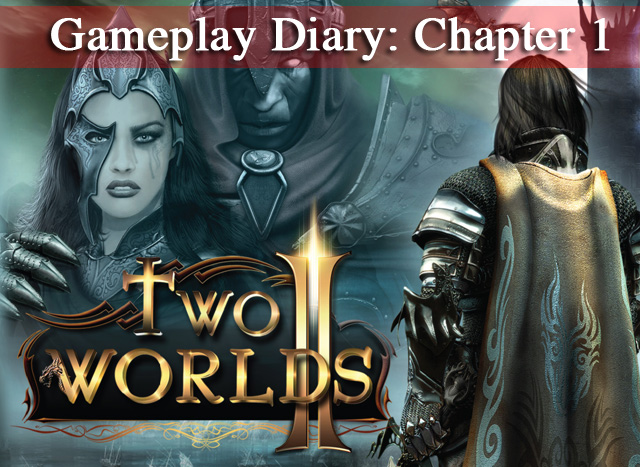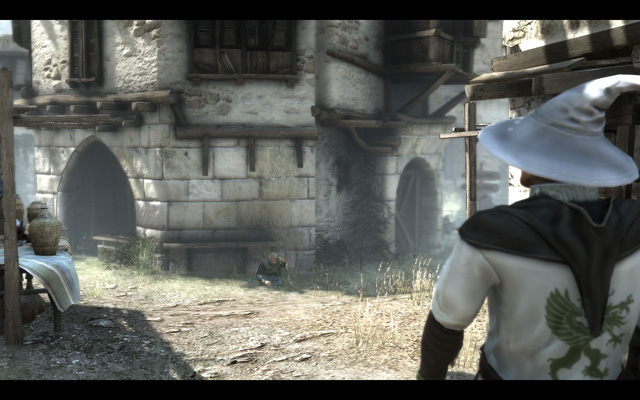
Written by: Dalibor Dimovski, Managing Editor
In the lead-up to our review of the game, our Two Worlds II diary examines our immediate reactions to playing through each chapter of the latest release from SouthPeak, TopWare, and Reality Pump
When Two Worlds II was announced, I have to admit that I gave a blank stare or two. I had never played (or even remembered) the original game, and from what I’ve since read about it I am better off for not doing so. When we first had a chance to see Two Worlds II at PAX East in 2010, I felt that it looked interesting but there was a still a feeling in the back of my mind that this game couldn’t compete with the Dragon Ages and Final Fantasies.
Had the game landed in our laps in October or November for review, it would have been buried by the busy release schedule. But instead, Southpeak pushed the release back into January, at a time when the major holiday rush had ended and we were about to welcome the first onslaught of 2011’s blockbusters. There was enough room in January and February to squeeze it in And as such, I’m currently playing my way through it, finding that it is much (MUCH) bigger than I had initially planned. Our review would take a bit more time as we worked to really get into the RPG.
So, until the review is completed later this week, we’ve opted to try a diary of our gameplay based on the game’s chapter breakup to help you understand how we’ve been playing it and how we’ve felt along the way.
This is the first part of the gameplay diary, including the Introduction tutorial and Chapter 1.

Played on: Xbox 360
After a nice, flashy FMV sequence detailing an epic orc vs human war, the game begins with a character creation sequence. Head, hair, body type; it’s all there. But so are creation details that go into so much minutia that it quickly becomes tedious: Brow height. Brow angle. Eye angle. INNER eye angle. It’s great if you happen have an hour to fine-tune the look of your character. I don’t. I want to actually play the game, and this first part seems like a roadblock to do just that. After a few initial facial tweaks, I give up and accept the rest of the default characteristics. I can tell almost instantly that this game would be stat-heavy like no other RPG I’ve recently played.
The game opens with a traditional escape from a dungeon-like prison. It’s an RPG staple that wouldn’t be so bad if it wasn’t for the awkward camera angles and floaty, slippery running motion. It’s overly-sensitive, with every movement of the right trigger resulting in my poor ragged hero madly spinning about. The dungeon is meant to be a tutorial, setting up running, sword-fighting, and lock-picking as I make my escape. Its pace is slow enough that it feels tedious, light on action until the very end of the escape.
The next section has me taking on squads of enemies as I traverse a jungle, and this is where two things become very apparent to me: the action-based combat is finicky and difficult to control, and the styles of combat (Warrior, Archer, Mage) are deep and complex. Where some RPGs stop at conditioning strength and speed of archery, Two Worlds II mixes in draw, distance, multiple shots, light summoning (with arrows!) and more… all at once. It’s almost overwhelming. Scratch that; it IS overwhelming. Instead of a gradual tutorial on the abilities I am thrown right into all of it.
Again, the game is stat-heavy.

I’m teleported back and forth between cities and jungles in this first chapter, solving riddles and quests along the way not unlike an open world game. In fact, with so many diversions on my quest, I’ve forgotten what my next steps are. Rescuing my sister is the overarching goal, but I’m becoming easily distracted along the way. At first I felt like I was running in circles, but as I grinded away at each little sidequest I was advancing my character’s stats. The level-up indication is a blue glow enveloping the hero, but the action remains constant instead of breaking into the stat improvement screen. I realize that it’s meant to prevent the action from being interrupted mid-battle, but I often forget to check back afterwards, resulting in a massive stat dump every few level raises.
Most of the quests, both along the main goal and the sidequests, are fetch quests. “For me to help you, go talk to this wizard. To talk to the wizard, go find a magic scroll. To get the magic scroll, get the compass from the tower.” And so on. It’s not structured to tell a story, but rather to keep me checking the box along the main path.
I’m quickly realizing that story and character development, visuals and voice acting aren’t the main reasons that this game exists. Developer Reality Pump has created an incredible crafting and stat-based advancement system, and using that as the backbone for the game.
I decide to quickly complete the first chapter, abandoning the sidequests I was on for the sake of time… and sanity. Unfortunately, the boss battle at the end of this first part is excruciatingly ill-designed. One or two well-placed hits and I’ve been decimated. After an hour of trying several strategies, I finally find one that works: hit and run. It’s a cheap battle, and one that doesn’t make me too excited for the remainder of the game. I’ve been thrown into the open world ocean without so much as a life raft.
This game, sadly, may not be for me.
End of Chapter 1
Disclosure: This gameplay diary is based on a copy of the game for the Xbox 360 provided by the publisher.


3 Comments